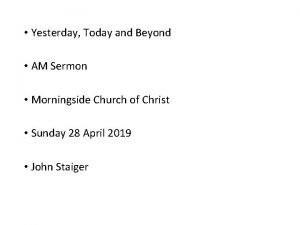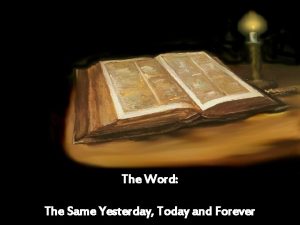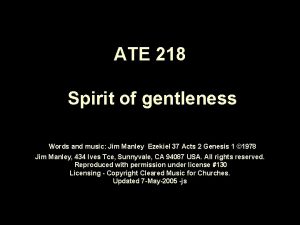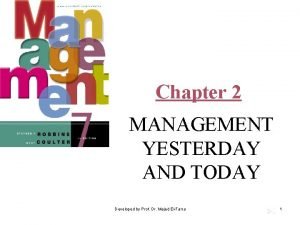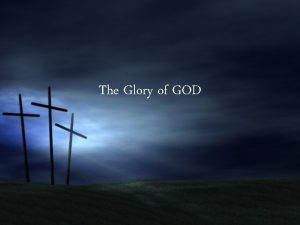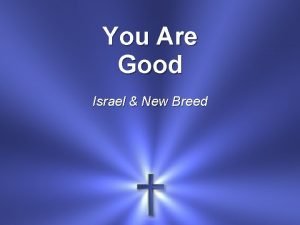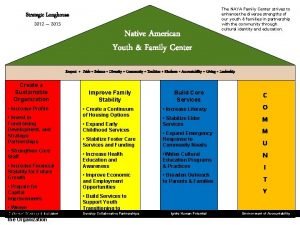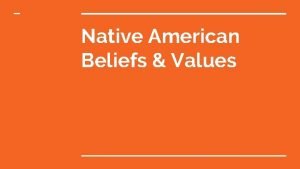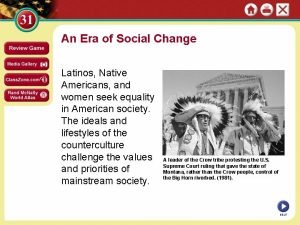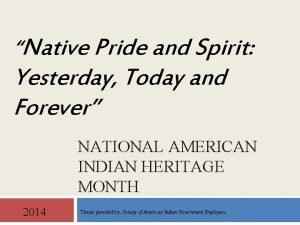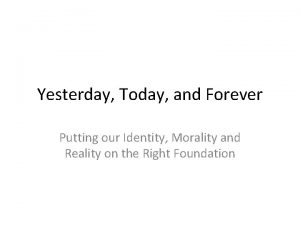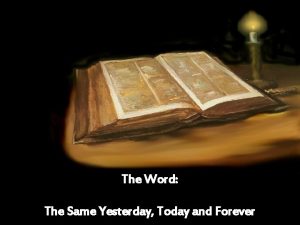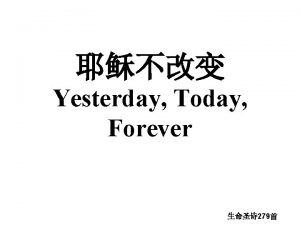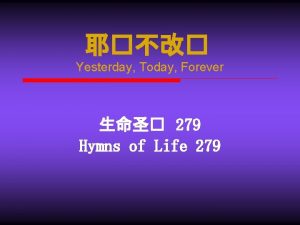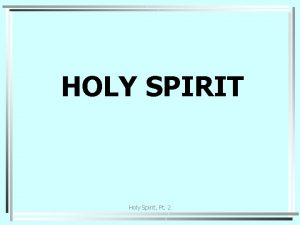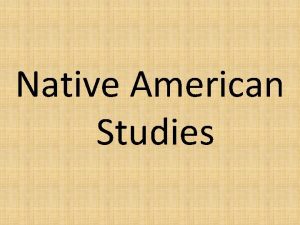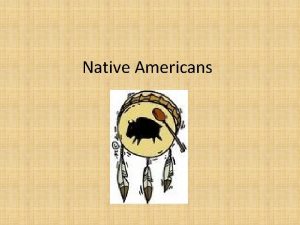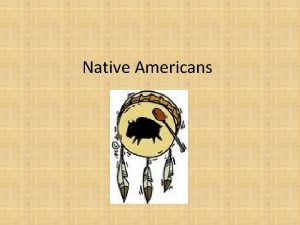NATIVE PRIDE AND SPIRIT YESTERDAY TODAY AND FOREVER
































- Slides: 32

NATIVE PRIDE AND SPIRIT: YESTERDAY, TODAY AND FOREVER Tracing Your Tribal Ancestry SAIGE Training Conference Thursday, June 12, 2014 1

2 Objectives Increased Awareness of the role of Special Emphasis Program Managers in Diversity and Inclusion for USDA Importance of Self Identification as American Indian/Alaska Native Tracing Indian Ancestry

3 Definition of Genealogy the study of family history. the history of a particular family showing how the different members of the family are related to each other “genealogy” and “family history” are used synonymously Some say genealogy is quantifiable

4 Why Trace Your Ancestry? To become an enrolled member of a federally recognized tribe To preserve family cultural and ethnic traditions for future generations. Verify family history and tradition that you descended from an AIAN To provide your children with a sense of who their ancestors were, where they came from and how they lived their lives. Curious and just want to learn more about your roots Start with YOU. Learn everything you can about your immediate family then move on to your family: Parents, grandparents, distant ancestors. Collect factual information.

5 Research Basics Preparing to Search What to Look For Where to Look Correspondence Tracking Your Progress Computer Software Putting It All Together

6 Tribal Eligibility Do NOT begin with the Bureau of Indian Affairs (BIA) To determine if you are eligible for membership in a federally recognized tribe, contact the tribe, or tribes, you claim ancestry from. Individual tribes set their own tribal enrollment requirements.

7 Determine Tribal Eligibility When establishing descent from an Indian tribe for membership and enrollment purposes, the individual must provide genealogical documentation. Documentation must prove that the individual lineally descends from an ancestor who was a member of the federally recognized tribe from which the individual claims descent.

8 Determine Tribal Eligibility - BIA When people believe they may be of American Indian ancestry, they immediately write or telephone the nearest Bureau of Indian Affairs (BIA) office for information. Many people think that the BIA retrieves genealogical information from a massive national Indian registry or comprehensive computer database. This is not true.

9 Determine Tribal Eligibility - BIA Most BIA offices, particularly the central (headquarters, Washington, DC) and area (field) offices do not keep individual Indian records BIA does not maintain a national registry. The BIA does not conduct genealogical research for the public.

10 What You Need to Know About BIA The BIA no longer has extensive involvement in tribal membership. Current Federal policy and case law limits the involvement of the BIA in tribal membership matters unless mandated by congressional legislation, or is required by the tribe's governing document or otherwise requested by the tribe. When you contact a BIA field office, be prepared to give the name of the tribe, the name(s) and birth dates of ancestor(s), and relationships. You must provide specific information otherwise field offices (and other institutions) probably cannot provide much useful information. The Privacy Act, 5 U. S. C. § 552(a) protects the current tribal membership rolls and lists that the BIA maintains. Submitting a request for genealogical information under the Freedom of Information Act, 5 U. S. C. § 552, is not necessary for records compiled and published by private institutions or available in census records declassified by the National Archives.

11 What You Need to Know About BIA Offices – Limited resource If your ancestors had land in trust or went through probate, the BIA field offices in selected areas throughout the United States may have some records concerning Indian ancestry. BIA field offices do not maintain current or historic records of all individuals who possess some degree of Indian blood. The records the BIA holds are current rather than historic tribal membership enrollment lists. These lists (commonly called "rolls") do not have supporting documentation (such as birth certificates) for each tribal member listed. The BIA created these rolls while the BIA maintained tribal membership rolls.

12

13 Genealogy References Tracing American Indian or Alaska Native ancestry can be found in these resources: Ancestry - General statement on tracing your American Indian ancestry for purposes of enrolling in a federally recognized American Indian tribe.

14 Genealogy References Genealogical Research - Provides general information as to where individuals can look in order to find the appropriate information they need to support their effort. Enrollment Process - Provides a general description on what the Enrollment Process to a federally recognized tribe involves.

15 Genealogy References Benefits & Services Provided to American Indians and Alaska Natives - Provides a general description on what benefits and services are available to American Indians and Alaska Natives. Cherokee Indian Ancestry - There are three federally recognized Cherokee Tribes that have different requirements for enrollment in their tribes.

16 Genealogy References Dawes Rolls -The Dawes Commission was organized in 1893 to accept applications for tribal enrollment between 1893 -1907 from American Indians of the Five Civilized Tribes who resided in Indian Territory, which later became the eastern portion of Oklahoma. Contacting a Tribal Entity - The BIA Tribal Leaders Directory lists the name, address and phone number of all the Federally Recognized Tribes.

17 Genealogy References Benefits & Services Provided to American Indians and Alaska Natives - Provides a general description on what benefits and services are available to American Indians and Alaska Natives.

18 Getting Started Family & Home Sources* Getting Started -First Steps Clues from Family Sources Names Dates Places Gathering Oral Histories Ask the Right Question Citing Family Sources Previous Research Family Cemeteries Putting It All Together, Store it in a safe and secure place, and Share with another family member Use only approved document sheet protectors

19 Where To Look For Information At Home The first place to begin genealogical research is at home. Valuable information can be found in: Family Bibles, newspaper clippings, military certificates, birth and death certificates, marriage licenses, diaries, letters, scrapbooks, backs of pictures and baby books. Relatives, particularly older ones, are another good source of information. Persons doing this research should visit or write family members who may have the genealogical information that they are seeking. Someone else in your family may also be working on a family history.

20 Important Vital Records Birth, Marriage, Death, Divorce, Census – Tribal Rolls Why Vital Records Birth Records Marriage Records Death Records Divorce Records Census – Tribal Rolls Certificate of Indian Blood How to Find and Obtain Vital Records Source Citations for Vital Records

21 Where To Look - State and Local Level School, church, and county courthouse records for information. Don’t limit the scope of search to birth, death and marriage records. Historical and genealogical information can be found in other civil records at the county courthouse such as deeds, wills, land or other property conveyances. Bureau of Vital Statistics - request copies of birth, death and marriage certificates, or divorce decrees. Include the name of the individual, date and place of birth and your relationship to that person. State governments did not keep birth and death records until the turn of the century, about 1890 -1915. Search state records for ancestors who were born or died before that time may be limited.

22 Where do I look - Public libraries and other Repositories Local libraries is a good starting point for gathering facts about Indians and Indian tribes. A wealth of information exists concerning the history of Indian tribes, tribal cultures, the historic tribal territories, and the migration patterns. Most libraries also have books on how to do genealogical research. Researchers can also contact genealogical organizations, historical societies, and other private institutions. For example, the Family History Centers are "branch offices" of the Family History Library of the Church of Jesus Christ of Latter-day Saints (Mormon). This private institution contains a large collection of genealogical documents relating to Indians that may be useful in research.

23 National Archives

24 Where do I look- National Archives The National Archives (Archives) in Washington, D. C. has records of genealogical value. The Federal government took the census every ten years since 1790 Census records from 1790 -1920 are available on microfilm in the National Archives' regional branches. 17 branch offices are in major metropolitan areas throughout the country.

25 Where do I look- National Archives and Records Administration, Publication and Distribution Staff (NECD), Room G-3, Eighth St. and Pennsylvania Ave. , NW Washington, D. C. 20408 -0001. The National Archives also has military and service related records, passenger arrival records, and other records of value to persons involved in genealogical research. The National Archives has various publications for sale. Individuals can purchase copies of the microfilm rolls and associated genealogical materials. Various rolls of microfilm are available for rental at the National Archives The National Archives website is www. nara. gov.

26 Where do I look- National Archives Records Concerning American Indians Now is the time to begin research in records about American Indians. The Native American collection at the National Archives includes: Special census, School records, and Allotment records. For more information concerning the special censuses of various tribes, the National Archives offers: Microfilm Publication M 1791 American Indian Censuses The Special Census of Indians, 1880.

27 Where do I look- National Archives World War I Draft Registration Cards Access the cards at Archives. gov Indian Census Rolls, 1885 -1940 Access. Genealogy. com Genealogy forms are available for public use from the website

28 What To Know About Adoption The Bureau of Indian Affairs cannot help you with your pursuit of opening closed adoption papers. There are organizations that can be found on the Internet that can assist you with information on what information may be needed. The BIA does not endorse or recommend any of them. You will need to obtain legal advice from a lawyer that deals with this area of the law.

29 Can I hire researchers to help me? Researchers are available for a fee. Board of Certification of Genealogists or the Association of Professional Genealogists and request their listings of genealogical researchers for hire. Their addresses are: Board of Certification of Genealogists P. O. Box 14291 Washington, D. C. 20044 Association of Professional Genealogists P. O. Box 40393 Denver, Colorado 80204

30 Tips - Keep Organized Keep your family research organized so you will know what records you have, what information and documents you still need, and a place to put all this information Develop a checklist for the following: Birth Record Death Records Probate Record Military Record Marriage and Children US Census Record State and County Census Record Mortality Schedule Land Grants and Deeds Voting Records Immigration and Naturalization Records Newspaper Articles Miscellaneous Records

31 Resources Family Search: American Indian Genealogy Records Family Search: American Indian Census Rolls Access Genealogy: Native American History and Genealogy http: //www. cyndislist. com/native-american/ Genealogy Branches: Native Americans - Online Native American Indian Genealogy Records & Databases. Including Links to Dawes Commission Records & Indexes for Individual Tribes http: //www. accessgenealogy. com/native/ Cyndi’s List: Native American https: //familysearch. org/learn/wiki/en/American_Indian_Genealogy http: //www. genealogybranches. com/nativeamericans. html State Genealogy sites Ancestry. com

32 Thank You and Wish You the Best as You Discover Your Family Beatrice Herbert 202 -690 -6370 Beatrice. Herbert@fsis. usda. gov
 Yesterday, today and forever sermon
Yesterday, today and forever sermon Give thanks michael w smith
Give thanks michael w smith Same today tomorrow and forever
Same today tomorrow and forever Come holy spirit, come hymn
Come holy spirit, come hymn Spirit spirit of gentleness
Spirit spirit of gentleness Management yesterday and today
Management yesterday and today Agriculture- yesterday today and tomorrow
Agriculture- yesterday today and tomorrow Today's problems come from yesterday's solutions
Today's problems come from yesterday's solutions Yesterday is a lesson today is
Yesterday is a lesson today is Royal family yesterday today is tomorrow
Royal family yesterday today is tomorrow For today's meeting
For today's meeting In todays lesson
In todays lesson Proposal kickoff meeting agenda
Proposal kickoff meeting agenda Galton details
Galton details Today's lesson or today lesson
Today's lesson or today lesson Today's lesson or today lesson
Today's lesson or today lesson Situational irony in pride and prejudice
Situational irony in pride and prejudice Message of the poem farewell liberty
Message of the poem farewell liberty Lord you are good and your mercy endureth
Lord you are good and your mercy endureth You are good you are good and your love endures
You are good you are good and your love endures Long walk to forever
Long walk to forever Straight angle
Straight angle Toonpool
Toonpool All glory to god
All glory to god Kinds of glory
Kinds of glory Forever and ever amen
Forever and ever amen Listen to god and live forever
Listen to god and live forever We worship you hallelujah
We worship you hallelujah Swot analysis of forever 21
Swot analysis of forever 21 Native american youth and family center
Native american youth and family center Native american morals and values
Native american morals and values Latinos and native americans seek equality
Latinos and native americans seek equality To serve with pride and dedication
To serve with pride and dedication
